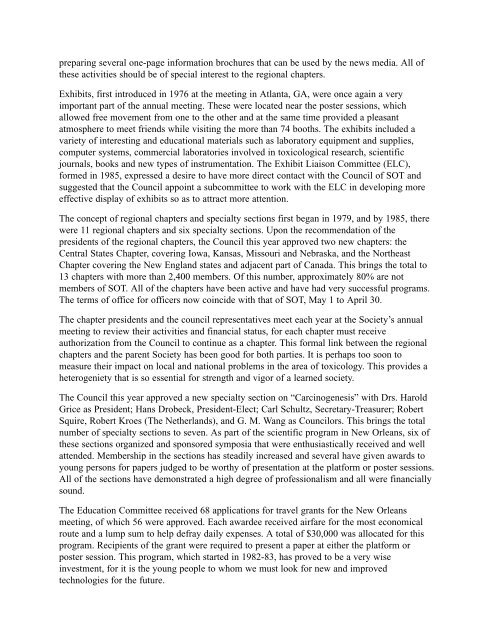SOCIETY O. TOXICOLOGY HISTORY - Society of Toxicology
SOCIETY O. TOXICOLOGY HISTORY - Society of Toxicology
SOCIETY O. TOXICOLOGY HISTORY - Society of Toxicology
Create successful ePaper yourself
Turn your PDF publications into a flip-book with our unique Google optimized e-Paper software.
preparing several one-page information brochures that can be used by the news media. All <strong>of</strong><br />
these activities should be <strong>of</strong> special interest to the regional chapters.<br />
Exhibits, first introduced in 1976 at the meeting in Atlanta, GA, were once again a very<br />
important part <strong>of</strong> the annual meeting. These were located near the poster sessions, which<br />
allowed free movement from one to the other and at the same time provided a pleasant<br />
atmosphere to meet friends while visiting the more than 74 booths. The exhibits included a<br />
variety <strong>of</strong> interesting and educational materials such as laboratory equipment and supplies,<br />
computer systems, commercial laboratories involved in toxicological research, scientific<br />
journals, books and new types <strong>of</strong> instrumentation. The Exhibit Liaison Committee (ELC),<br />
formed in 1985, expressed a desire to have more direct contact with the Council <strong>of</strong> SOT and<br />
suggested that the Council appoint a subcommittee to work with the ELC in developing more<br />
effective display <strong>of</strong> exhibits so as to attract more attention.<br />
The concept <strong>of</strong> regional chapters and specialty sections first began in 1979, and by 1985, there<br />
were 11 regional chapters and six specialty sections. Upon the recommendation <strong>of</strong> the<br />
presidents <strong>of</strong> the regional chapters, the Council this year approved two new chapters: the<br />
Central States Chapter, covering Iowa, Kansas, Missouri and Nebraska, and the Northeast<br />
Chapter covering the New England states and adjacent part <strong>of</strong> Canada. This brings the total to<br />
13 chapters with more than 2,400 members. Of this number, approximately 80% are not<br />
members <strong>of</strong> SOT. All <strong>of</strong> the chapters have been active and have had very successful programs.<br />
The terms <strong>of</strong> <strong>of</strong>fice for <strong>of</strong>ficers now coincide with that <strong>of</strong> SOT, May 1 to April 30.<br />
The chapter presidents and the council representatives meet each year at the <strong>Society</strong>’s annual<br />
meeting to review their activities and financial status, for each chapter must receive<br />
authorization from the Council to continue as a chapter. This formal link between the regional<br />
chapters and the parent <strong>Society</strong> has been good for both parties. It is perhaps too soon to<br />
measure their impact on local and national problems in the area <strong>of</strong> toxicology. This provides a<br />
heterogeniety that is so essential for strength and vigor <strong>of</strong> a learned society.<br />
The Council this year approved a new specialty section on “Carcinogenesis” with Drs. Harold<br />
Grice as President; Hans Drobeck, President-Elect; Carl Schultz, Secretary-Treasurer; Robert<br />
Squire, Robert Kroes (The Netherlands), and G. M. Wang as Councilors. This brings the total<br />
number <strong>of</strong> specialty sections to seven. As part <strong>of</strong> the scientific program in New Orleans, six <strong>of</strong><br />
these sections organized and sponsored symposia that were enthusiastically received and well<br />
attended. Membership in the sections has steadily increased and several have given awards to<br />
young persons for papers judged to be worthy <strong>of</strong> presentation at the platform or poster sessions.<br />
All <strong>of</strong> the sections have demonstrated a high degree <strong>of</strong> pr<strong>of</strong>essionalism and all were financially<br />
sound.<br />
The Education Committee received 68 applications for travel grants for the New Orleans<br />
meeting, <strong>of</strong> which 56 were approved. Each awardee received airfare for the most economical<br />
route and a lump sum to help defray daily expenses. A total <strong>of</strong> $30,000 was allocated for this<br />
program. Recipients <strong>of</strong> the grant were required to present a paper at either the platform or<br />
poster session. This program, which started in 1982-83, has proved to be a very wise<br />
investment, for it is the young people to whom we must look for new and improved<br />
technologies for the future.
















